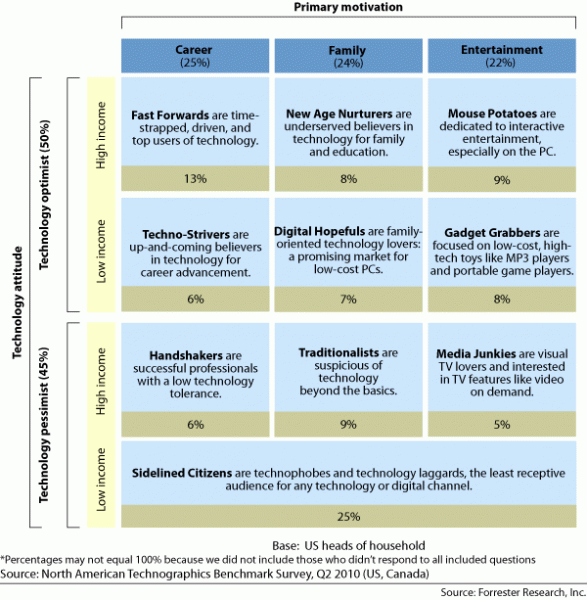Device Adoption Made Simple
Right now, I am knee-deep in data while writing our annual Benchmark Data Overview report. We’ve been writing these reports for more than 10 years now. (In fact, for a little blast from the past, check out the report from 2001 where we noted that just over half of online consumers over the age of 55 knew how to bookmark a Web site.) The 2001 report used our Technographics® segmentation as a framework for understanding how consumers were integrating technology into their lives. The segmentation was created in 1997 when we first began collecting our Technographics data to help companies understand and predict changes in the consumer technology landscape. It is built on three main components: motivation, income, and technology optimism/pessimism using a proprietary algorithm. The graphic below illustrates the various groups of the segmentation:

We’ve used the segmentation for 13 years now to help clients predict and understand consumer technology adoption. In my 2007 report, I tested the segmentation against MP3 player adoption to see if it would hold up — and, it did! So, as I’ve been mining all the data for our upcoming report, I thought I’d put the segmentation to the test again (because, let’s face it, at heart I’m a data dork and love to explore these things). I decided to use eReaders as a test. The Benchmark data (pulled from our annual offline North American Technographics survey) shows overall adoption of eReaders at about 2%. So, looking at the segment groups above, which group would you guess has the highest adoption? I’ll give you a minute . . . Did you say Fast Forwards? If you did, you’re right! Twenty-five percent of all eReaders are owned by Fast Forwards, 18% by Mouse Potatoes. This is just what you'd expect given that Fast Forwards are all about having the latest and greatest gadget, no matter what it is while Mouse Potatoes love new technologies that facilitate their love of entertainment!
So, whether it’s the DVD penetration we tried to predict back in 2001 or the iPad today, the segmentation serves as the perfect framework to help you understand the intersection of consumers and technologies. If you need to understand the potential adoption of nascent technologies and how this could affect your consumers, come talk to me and we can examine just who you should be targeting.
Now, be honest and tell me — did you get the answer right?